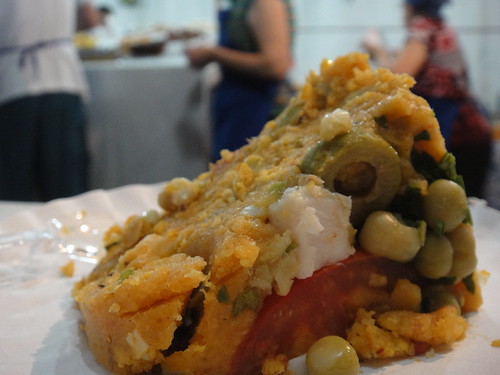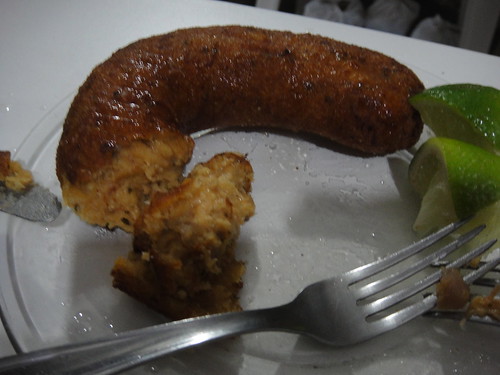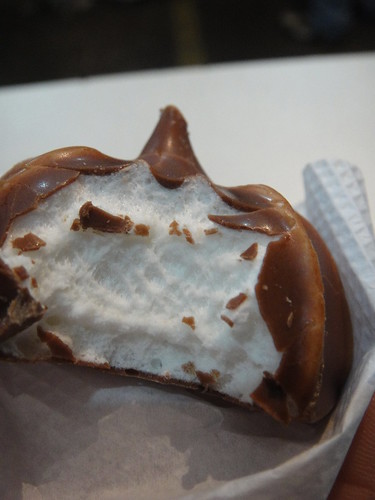
It’s getting colder here in Brazil and dry season is approaching. In the North, the crops have been harvested. Festa Junina (June Festival) was carried over from the Portuguese to celebrate and thank God for the rain by eating wonderful foods--and like any good Brazilian party it has mutated into one of the biggest parties of the year. On any given weekend night during the month of June at most Catholic churches, there are festivities, country music, line dancing or
quadrilha and loads of foods and hot wine and liquor to warm you up. Proceeds usually go to charities or the churches themselves, all while everyone gets fat and merry.
Festa Junina is most popular in the rural North but is hosted in cities and dusty towns all across Brazil. The North is well-known for their Junina parties that have broken Guinness records for the "Largest Country Western Party".
Donning my "costume" (plaid shirt for men), I finally made it over to Nossa Senhora do Calvário Church, overlooking Benedito Calixto Plaza in Pinheiros, a hip hood in São Paulo, for my share of food, drink, and cheesy Brazilian country music also known as
sertanejo universitario.

"We are the cheesy Brazilian country singers!"

But the real traditional music is called
forró, a blend of polka and Brazilian rhythms.
Forró (foh-hall) a term used all over Brazil, is said to be used by USAF stationed in Brazil ages ago meaning: "for all", which refers to the dance halls and parties meant for all.
 The only guy dancing for the first two hours.
The only guy dancing for the first two hours.
The line for the entrance wrapped around the block and upon entry I saw the hoard.

Where were all the men and boys with blackened teeth, dressed in farmer costumes and where were the girls dressed in dresses promenading with penciled in freckles and rosy cheeks? Then I realized which neighborhood I was in, and it dawned on me that I was at the hipster Festa Junina, where the crowd was too cool to dress up and too cool to square dance. I was soon over my disappointment when I saw the spread.

One girl dressed up, and she ate tempura from the Japanese booth.

The food, donated by members of the church and the food stalls are mostly run by volunteers eager to raise money for their charity.
I headed to the beverages and found super hot quentão which is a mix of sugar, water, cinnamon, ginger, and cachaça.
 A volunteer pouring some quentão.
A volunteer pouring some quentão.
Then I found
vinho quente and fell in love with the hot wine mixed with fruits (like sangria). I stuck with this for the rest of the night.
 Vats of hot wine and a super cute old couple.
Vats of hot wine and a super cute old couple.
 Vinho quente and some sweet lips.
Vinho quente and some sweet lips.
Booths were serving varieties of different Bahian foods (from the state of Bahia, where there is a distinct African-Brazilian influence), barbecue, Portuguese, Italian, and even Japanese food.
 A Baiana woman serving up some Bahiano food.
A Baiana woman serving up some Bahiano food.
Acaraje: made from peeled black eyed peas and then deep fried in palm oil:
 Cuz Cuz
Cuz Cuz: Brazilian cous-cous with tomato, corn, peas, tomato, mushroom mixed into what is almost like a moist loafy cous cous pie:

Pinhão, a large seed that peels like corn but goes down like large fibrous flower seeds:

Peel it:

Wait for it...
 BOINGGG! Yes, you can eat it now.
BOINGGG! Yes, you can eat it now.
Corn on the cob:
 Alheira
Alheira is a type of porkless sausage invented by Jewish Portuguese to trick the inquisition:
 v
v
Mr. Amaury explains the process to make
alheira:
 Arroz doce
Arroz doce or sweet rice topped with cinnamon:

Gnocchi:
 Teta de nega
Teta de nega (black nipple):
 A nipply dessert.
A nipply dessert.
Nipple nectar of the gods: traditional
maria-mole, a very soft coconut gelatin:

Carnival games:



Now that July is here, the real cold is about to begin. Bring on the hot wine.
 It’s getting colder here in Brazil and dry season is approaching. In the North, the crops have been harvested. Festa Junina (June Festival) was carried over from the Portuguese to celebrate and thank God for the rain by eating wonderful foods--and like any good Brazilian party it has mutated into one of the biggest parties of the year. On any given weekend night during the month of June at most Catholic churches, there are festivities, country music, line dancing or quadrilha and loads of foods and hot wine and liquor to warm you up. Proceeds usually go to charities or the churches themselves, all while everyone gets fat and merry.
Festa Junina is most popular in the rural North but is hosted in cities and dusty towns all across Brazil. The North is well-known for their Junina parties that have broken Guinness records for the "Largest Country Western Party".
Donning my "costume" (plaid shirt for men), I finally made it over to Nossa Senhora do Calvário Church, overlooking Benedito Calixto Plaza in Pinheiros, a hip hood in São Paulo, for my share of food, drink, and cheesy Brazilian country music also known as sertanejo universitario.
It’s getting colder here in Brazil and dry season is approaching. In the North, the crops have been harvested. Festa Junina (June Festival) was carried over from the Portuguese to celebrate and thank God for the rain by eating wonderful foods--and like any good Brazilian party it has mutated into one of the biggest parties of the year. On any given weekend night during the month of June at most Catholic churches, there are festivities, country music, line dancing or quadrilha and loads of foods and hot wine and liquor to warm you up. Proceeds usually go to charities or the churches themselves, all while everyone gets fat and merry.
Festa Junina is most popular in the rural North but is hosted in cities and dusty towns all across Brazil. The North is well-known for their Junina parties that have broken Guinness records for the "Largest Country Western Party".
Donning my "costume" (plaid shirt for men), I finally made it over to Nossa Senhora do Calvário Church, overlooking Benedito Calixto Plaza in Pinheiros, a hip hood in São Paulo, for my share of food, drink, and cheesy Brazilian country music also known as sertanejo universitario.
 "We are the cheesy Brazilian country singers!"
"We are the cheesy Brazilian country singers!"
 But the real traditional music is called forró, a blend of polka and Brazilian rhythms. Forró (foh-hall) a term used all over Brazil, is said to be used by USAF stationed in Brazil ages ago meaning: "for all", which refers to the dance halls and parties meant for all.
But the real traditional music is called forró, a blend of polka and Brazilian rhythms. Forró (foh-hall) a term used all over Brazil, is said to be used by USAF stationed in Brazil ages ago meaning: "for all", which refers to the dance halls and parties meant for all.
 The only guy dancing for the first two hours.
The line for the entrance wrapped around the block and upon entry I saw the hoard.
The only guy dancing for the first two hours.
The line for the entrance wrapped around the block and upon entry I saw the hoard.
 Where were all the men and boys with blackened teeth, dressed in farmer costumes and where were the girls dressed in dresses promenading with penciled in freckles and rosy cheeks? Then I realized which neighborhood I was in, and it dawned on me that I was at the hipster Festa Junina, where the crowd was too cool to dress up and too cool to square dance. I was soon over my disappointment when I saw the spread.
Where were all the men and boys with blackened teeth, dressed in farmer costumes and where were the girls dressed in dresses promenading with penciled in freckles and rosy cheeks? Then I realized which neighborhood I was in, and it dawned on me that I was at the hipster Festa Junina, where the crowd was too cool to dress up and too cool to square dance. I was soon over my disappointment when I saw the spread.
 One girl dressed up, and she ate tempura from the Japanese booth.
One girl dressed up, and she ate tempura from the Japanese booth.
 The food, donated by members of the church and the food stalls are mostly run by volunteers eager to raise money for their charity.
I headed to the beverages and found super hot quentão which is a mix of sugar, water, cinnamon, ginger, and cachaça.
The food, donated by members of the church and the food stalls are mostly run by volunteers eager to raise money for their charity.
I headed to the beverages and found super hot quentão which is a mix of sugar, water, cinnamon, ginger, and cachaça.
 A volunteer pouring some quentão.
Then I found vinho quente and fell in love with the hot wine mixed with fruits (like sangria). I stuck with this for the rest of the night.
A volunteer pouring some quentão.
Then I found vinho quente and fell in love with the hot wine mixed with fruits (like sangria). I stuck with this for the rest of the night.
 Vats of hot wine and a super cute old couple.
Vats of hot wine and a super cute old couple.
 Vinho quente and some sweet lips.
Booths were serving varieties of different Bahian foods (from the state of Bahia, where there is a distinct African-Brazilian influence), barbecue, Portuguese, Italian, and even Japanese food.
Vinho quente and some sweet lips.
Booths were serving varieties of different Bahian foods (from the state of Bahia, where there is a distinct African-Brazilian influence), barbecue, Portuguese, Italian, and even Japanese food.
 A Baiana woman serving up some Bahiano food.
Acaraje: made from peeled black eyed peas and then deep fried in palm oil:
A Baiana woman serving up some Bahiano food.
Acaraje: made from peeled black eyed peas and then deep fried in palm oil:
 Cuz Cuz: Brazilian cous-cous with tomato, corn, peas, tomato, mushroom mixed into what is almost like a moist loafy cous cous pie:
Cuz Cuz: Brazilian cous-cous with tomato, corn, peas, tomato, mushroom mixed into what is almost like a moist loafy cous cous pie:
 Pinhão, a large seed that peels like corn but goes down like large fibrous flower seeds:
Pinhão, a large seed that peels like corn but goes down like large fibrous flower seeds:
 Peel it:
Peel it:
 Wait for it...
Wait for it...
 BOINGGG! Yes, you can eat it now.
Corn on the cob:
BOINGGG! Yes, you can eat it now.
Corn on the cob:
 Alheira is a type of porkless sausage invented by Jewish Portuguese to trick the inquisition:
Alheira is a type of porkless sausage invented by Jewish Portuguese to trick the inquisition:
 v
Mr. Amaury explains the process to make alheira:
v
Mr. Amaury explains the process to make alheira:
 Arroz doce or sweet rice topped with cinnamon:
Arroz doce or sweet rice topped with cinnamon:
 Gnocchi:
Gnocchi:
 Teta de nega (black nipple):
Teta de nega (black nipple):
 A nipply dessert.
Nipple nectar of the gods: traditional maria-mole, a very soft coconut gelatin:
A nipply dessert.
Nipple nectar of the gods: traditional maria-mole, a very soft coconut gelatin:
 Carnival games:
Carnival games:


 Now that July is here, the real cold is about to begin. Bring on the hot wine.
Now that July is here, the real cold is about to begin. Bring on the hot wine.




Comments (2)
Teta!!!!!
(I am a Japanese descendent Brazilian living in the US). Just needed to say your post is great! real description of Festa junina! awesome.